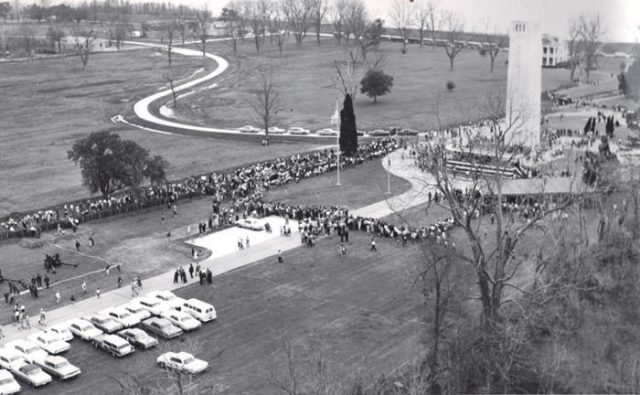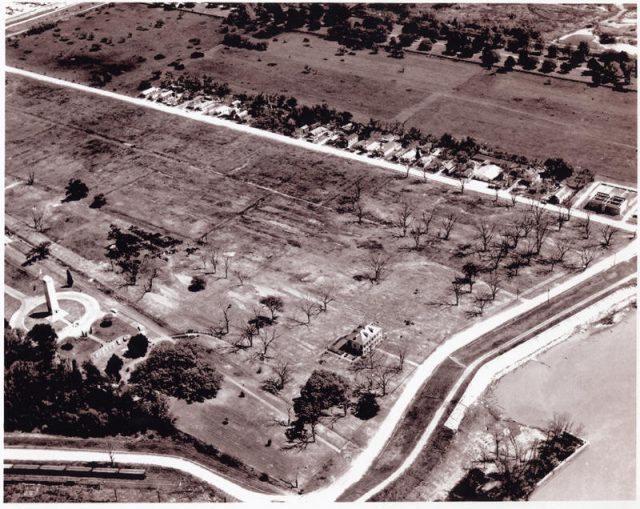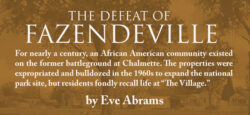Magazine
The Defeat of Fazendeville
The historically African American village of Fazendeville was destroyed to make room for a park devoted to the Battle of New Orleans
Published: January 8, 2015
Last Updated: May 3, 2019

Editor’s Note: The following feature will be adapted as a radio program on WWNO 89.9, New Orleans’ National Public Radio affiliate. Eve Abrams will be contributing additional features and broadcasts in issues to come as part of a new grant partnership between the Louisiana Endowment for the Humanities and the radio station. Click here to listen to the radio story.
When Eldgridge Cager was growing up in Fazendeville in the 1950s, he and his friends would look for cannonballs, broken muskets, and swords on the other side of the Mississippi River levee—just a few blocks from his house in the all-black community. They’d bring the rusty treasures to “Old Man” Linch, the park superintendent of the Chalmette Monument, a tall white obelisk towering over the cow pasture across from Fazendeville. The youngsters called the monument “the castle,” and in exchange for cannonballs the size of bowling balls, Linch let them run up the circular stairs, round and round to the very top. “We used to have races to see who gets up there the fastest,” recalls Cager. “I’m in my 60s now. I’ve tried to walk up there. Oh, boy.”Now nearly every trace of Cager’s boyhood community is gone, bulldozed while he was still a teenager for the sake of a war he knew only through its buried weaponry.
Cager grew up as one of 11 siblings in one of the last houses along the eastern side of Fazendeville Road, which stretched from the St. Bernard Highway to the Mississippi River, smack in the middle between the Chalmette National Monument and the Chalmette Cemetery. About 30 families lived in Fazendeville, and all, like the Cagers, went back generations—perhaps to its beginning around 1870, when Jean Pierre Fazende, a free man of color, New Orleans grocer, and opera lover began subdividing the slim tract of land he’d inherited from his father—also named Jean Pierre Fazende—and selling off parcels to recently freed slaves.
“He recognized that the freed slaves were in a very difficult transition,” says St. Bernard historian Bill Hyland, whose cousins and dear friends were descendants of Monsieur Fazende. “Something had to be done to provide for them. So they could transition from being slaves to being free people.”

The sesquecentennial of the Battle of New Orleans on January 8, 1965, with the remnants of Fazendeville visible in the background. Courtesy of NATIONAL PARK SERVICE.
Fazendeville, known to everyone who lived there as “The Village,” was comprised of 33 lots on one side of Fazendeville Road, which remained unpaved even after the St. Bernard Sewage and Water treatment plant was installed at the river end in 1959. There were houses, a school (which doubled as a dance hall at night), the Battleground Baptist Church, two benevolent associations, three bars, and a grocery store. Behind the houses, and the yards where many families grew vegetables and raised chickens, was an open pasture the community used as a baseball field. Peter Pierre, 72, hunted rabbits in the woods behind this field using broomsticks and dogs. He and his friends dug crawfish from the nearby ponds. At night, they peeked through the fence to watch the dances which followed baseball games. Fats Domino’s cousin, Freddie Domino, often played, and before he was famous, Fats himself came around to tickle the ivories. “Being from the Lower Ninth Ward, he knew people in Fazendeville,” explains Pierre, who says many of those who moved to the Lower Ninth Ward were from Fazendeville.
Across from the houses was a grove of pecan trees where Valerie Lindsey Schxnayder, 67, remembers gathering pecans. She can still recall from memory who lived in each house. So can Miriam Cager Jones, 75, who dreams frequently about The Village. Regina Pierre Woodridge, 67, says growing up in Fazendeville, “You couldn’t do nothing” without your parents hearing about it. “If you even stepped to the end of the porch, your mama would know.” It was an extremely tight-knit community, more like family—which, over generations, many became through marriage.
By the time Monsieur Pierre Fazende inherited his land—one slim arpent (58.5 meters) along the river side and stretching north into the cypress swamp—it had changed hands many times and was itself a subdivision of the Chalmette plantation, for which the entire area, a few miles downriver from The French Quarter, is named. Once part of a sugar plantation worked by enslaved people, the land is also the site of one of the most significant battles in U.S. history. “The whole future of the United States hung in what happened out here,” says historian Ron Chapman, referring to the Battle of New Orleans. Bill Hyland argues that if the British had taken the mouth of the river, they would have held the entire Mississippi as well as its valley, “and the westward expansion of United States could not, and would not, have taken place.” Without it, says Hyland, the United States would not have evolved into an economic global titan, and would differ greatly from the country we know today.
“The Battle of New Orleans was the day the nation celebrated its freedom,” explains Lance Hatten, the current superintendent of New Orleans’ national parks. “Up until the Civil War, it was like Independence Day for the nation.”
Growing up in Fazendeville, Miriam Cager Jones watched the annual commemorations for the Battle of New Orleans from her house, across the cow pasture. Her father, Eugene Cager, an activist and longshoreman, taught her about it. Eugene Cager believed stridently in both getting an education and being politically involved; he registered black people to vote before passage of the civil rights laws of the 1960s—at a time when doing so could get you fired, jailed, or even killed. His eldest daughter Miriam knew the battle had something to do with the War of 1812, and also that blacks had fought in it. “But we didn’t care about that,” she recalls. “Nobody cared about it.”
Several miles upriver, a group of Uptown New Orleans women cared desperately. In the mid 1800s, local citizens organized to erect a monument in honor of their ancestors’ sacrifice and Andrew Jackson’s victory. Dwindling funds and the Civil War stalled construction, but by the 1890s, the Louisiana Society of the United States Daughters of 1776 and 1812 passionately took up the cause. They successfully lobbied Congress and President Theodore Roosevelt for funding, and in 1908 the monument was at last complete. The Daughters were charged with its maintenance, which they financed by selling pecans and firewood. Meanwhile, on the other side of the pecan grove and Fazendeville, the city of New Orleans purchased another parcel of the Chalmette plantation, which, in 1868, became the Chalmette National Cemetery.

An aerial view of Fazendeville, circa 1960.
Courtesy Louisiana National Guard.
The monument and cemetery lands evolved in stages, and their oversight passed gradually and separately from local to national hands. In 1939, an act of Congress established Chalmette National Historical Park, which included both the monument and the cemetery under the auspices of the newly created National Park Service. Lyle Linch, “the old man” the children of Fazendeville remember shooing them from the pecan trees, was the superintendent of this park from 1954 to 1964. “People never did like him,” recalls Peter Pierre.
Pierre grew up in Fazendeville hearing the same refrain all his neighbors and cousins heard: “Get a good education; life will be so much better.” But he wanted to travel, and since he didn’t have any money, joined the military. Pierre was stationed in Fort Hood, Texas, when his family was forced to leave The Village in 1963, when the entirety of Fazendeville was seized by the federal government—its buildings razed, the pecan trees bulldozed—in order to unify and enlarge the park.
This did not come about suddenly. From its beginning, the National Park Service sought more land in Chalmette in order to create “a full-fledged national historical park” that would interpret the action of the Battle of New Orleans. Lands all around were sought after—including, to the east, those of their new industrial neighbor, Kaiser Aluminum. But sitting in the middle of the battlefield was Fazendeville—a living, breathing anachronism to the park’s historical vision. As the sesquicentennial of the Battle approached in 1962, the park service stepped up its efforts to create the historical memorial it had always envisioned.
The National Park Service had powerful allies. Among them was the Chalmette Chapter of the U.S. Daughters of 1812, headed by Mrs. Edwin X. de Verges, as well as her dear friend Martha Robinson, New Orleans’ grand dame of preservation, who headed the Louisiana Landmarks Society. Robinson championed women’s suffrage and child labor reform laws before turning her attention to historic preservation. She’s known for preserving the French Quarter and was part of the decades-long fight to keep an expressway from going through it. “She was absolutely indomitable,” says Bill Hyland, who knew her well. “Nothing intimidated her.”
Robinson went about methodically assembling different pie wedges of land to join the national park. Wielding influence and tenacity, she convinced both the railroad and the previously intractable Kaiser Aluminum to donate valuable acreage. Protecting a chapter of history was clearly at the forefront of Robinson’s agenda, yet dispossessing a community was the next, necessary step. “Rather than get tangled up with Martha Robinson,” write Abbye A. Gorin and Wilbur E. Meneray, “politicians considered an alternate course.” Several of these politicians—Congressman F. Edward Hebert, Senators Russell B. Long and Allen J. Ellender—took up Robinson’s cause. They introduced legislation in Congress to purchase land for the park in time for the Battle’s 150th anniversary. The resolution passed, and President Kennedy signed it into law just months before he was assassinated.
“The government did eminent domain on us in 1964,” explains Valerie Lindsey Schxnayder, whose father was the last to leave Fazendeville. He moved his entire home —by trailer—to Reynes Street in the Lower Ninth Ward, where it was flooded the following year in Hurricane Betsy, and swept down the block in Katrina. In the mid-1960s, the market price for a new home in St. Bernard was around $16,000; residents of Fazendeville received around $6,000 per home. With Lindsey and the other citizens of Fazendeville gone, The Village was wiped away.
“You can still see the scar on the land where Fazendeville was,” laments historian Ron Chapman, who wonders if anyone informed President Kennedy that expanding the park meant displacing a black community that had been there for nearly a hundred years. “These poor people were left on their own to fight a battle they had no capacity to win.” Disenfranchised from government, not even secure in the right to vote, what could the people of Fazendeville have done?, Chapman asks. “There are no cavalry coming over the hill. The people you thought were the cavalry are shooting at you.”
…sitting in the middle of the battlefield was Fazendeville—a living, breathing anachronism to the park’s historical vision.
“When I think of it, it’s full of bitterness,” says Donna Gant Williams, 73, whose family took a common diasporic route from Fazendeville to the Lower Ninth Ward. Her father, William Gant, was a minister of the Battleground Baptist Church. “They told us we have to extend the park from the monument to the graveyard. But everything is just gone. What service is it doing? It’s just wild grass. It’s not even oak trees.”
For Peter Pierre, the loss of Fazendeville still smites. “I guess they just figured it was time for them to go,” he imagines. “We’ll have this empty land for Chalmette Battlefield. We don’t need these blacks there. I guess that was their line of thought. Cause they never did anything with it.”
To many, something very powerful has been done with the land: it now stands much as it did on January 8, 1815—reminding visitors that an improbable, multicultural army of pirates, slaves, Creoles, free people of color, and militias from Tennessee and Kentucky defeated the army who had just defeated Napolean. “One of the things we can be proud of as we look back into history was who was engaged in the battle and who represented the city of New Orleans,” says Lance Hatten, who, as the current park superintendent, has the job of conveying its complex history.
The Battle of New Orleans amounted to a brutal miracle. “The British took the full force of their army and brought it to the New World to humble the United States,”explains Ron Chapman. “It had only been about 30 years since the end of the American Revolution, and they were mad about that.” But within half an hour of fighting, the British suffered approximately 2,000 casualties; Americans lost fewer than 20.
Bill Hyland says there’s no question that this history is what Martha Robinson and the Daughters of 1812 had singularly in mind. Perhaps they rationalized that destroying Fazendeville would provide its people an opportunity to move to better housing and circumstances. “Whether that’s the case or not is another matter,” says Hyland, who claims, 50 years later, we have a more nuanced view of culture and the past. “We know it’s a mistake to destroy the vestiges of our layered history, but at the time, we had not evolved to accept the value of the everyday.”
Chapmen says Fazendeville got caught in the switches. “One hundred and fifty years later, they too were victims of the Battle of New Orleans. There’s no way of getting around it. They lost everything.”
Dr. Marguerite Cager Scott, 70, was away at college when her family relocated from Fazendeville to Violet, Louisiana. Shortly thereafter, she moved to Connecticut, and when she returned to Louisiana some 40 years later to be near her grandchildren, Scott settled across the lake, in Slidell. “There is no place I can visualize in St. Bernard Parish where I wanted to live,” says the former teacher. “We grew up in Fazendeville, and there was no more Fazendeville.”
——–
Eve Abrams is a radio producer, writer, audio documentarian, and educator. Her stories regularly air on WWNO, New Orleans’ Public Radio and NPR station, as well as on WWOZ, New Orleans’ Jazz and Heritage Community Radio Station. Nationally, Eve’s work airs on The Tavis Smiley Show, This American Life, National Public Radio, Studio 360, The World, and Voice of America.
